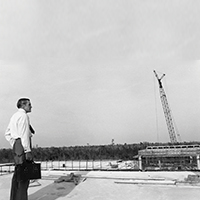twoColumn twoRight
Dr. Thomas G. Carpenter: Founding President Shaped UNF
 The University of North Florida community mourns the loss of our founding president, Dr. Thomas G. Carpenter. Carpenter headed the University from 1969 until 1980, making him the second longest-serving president in UNF’s history. He led the University from its initial planning through the first day of classes in 1972 and charted the course of its early growth.
The University of North Florida community mourns the loss of our founding president, Dr. Thomas G. Carpenter. Carpenter headed the University from 1969 until 1980, making him the second longest-serving president in UNF’s history. He led the University from its initial planning through the first day of classes in 1972 and charted the course of its early growth.As a young man, Carpenter played football at Georgia Tech and served in the Navy in the winddown of World War II. He earned his bachelor’s degree in business at Memphis State University and his master’s in economics from Baylor University. He then moved to Gainesville where he earned his Ph.D. in economics at the University of Florida in 1963.
Carpenter began his career in college administration at the University of Florida, working as assistant director of housing in addition to his studies and teaching. He subsequently served at Florida Atlantic University and the University of West Florida during their early years.
His success at those institutions led the Florida Board of Regents to select him as inaugural president of the University of North Florida. He took office on Aug. 1, 1969.
Both Thomas and his wife, Oneida Carpenter, left marks on UNF’s physical space. The campus’ Lake Oneida was named for his wife. And when the president left UNF in 1980, the University designated its new library, a pet project of his, the Thomas G. Carpenter Library. Today, the campus library is affectionately known to students as “Tommy G’s.”
Carpenter’s tenure has left a permanent legacy at UNF. His choices in hiring the first generation of staff and helping set the original curriculum established UNF’s reputation as a university that puts its students first. He also personally led the planning of the campus, including the design of the first buildings and the special emphasis on comfortable walkways, corridors and plazas connecting them. Though the later buildings have moved beyond the block-style Brutalist architecture of the early ones, the commitment to a walkable and welcoming campus remains a hallmark of the University.
Perhaps Carpenter’s most lasting legacy was his decision to designate UNF as a natural preserve in 1969. He and his staff endeavored to save as much of the campus’ natural state as possible, realizing it could become an attraction for students and visitors. Carpenter’s successors have built upon this decision by establishing the 382-acre Sawmill Slough Preserve, creating nature trails and outdoor recreation facilities, and embracing environmentally friendly building design. Few other decisions in UNF’s history have had such an enduring impact on shaping the University’s identity, culture and aesthetics.
After leaving UNF in 1980, Carpenter served as president of his alma mater, Memphis State University (now the University of Memphis) until retiring to North Carolina in 1991. In his retirement, Carpenter made periodic visits back to UNF, and he was known to marvel at how much the University had grown over the years.
In this Edition
- Alumna’s Lab Passes the Test
- Caring Ospreys: UNF Alumni In Healthcare
- Dr. Thomas G. Carpenter: Founding President Shaped UNF
- On-Campus COVID Testing Offers ‘Win-Win’
- Research Roundup: How does sitting for hours affect your heart?
- Research Roundup: Where will researchers find the next generation of drugs?
- UNF MedNexus: Ensuring the Future of Florida’s Healthcare
